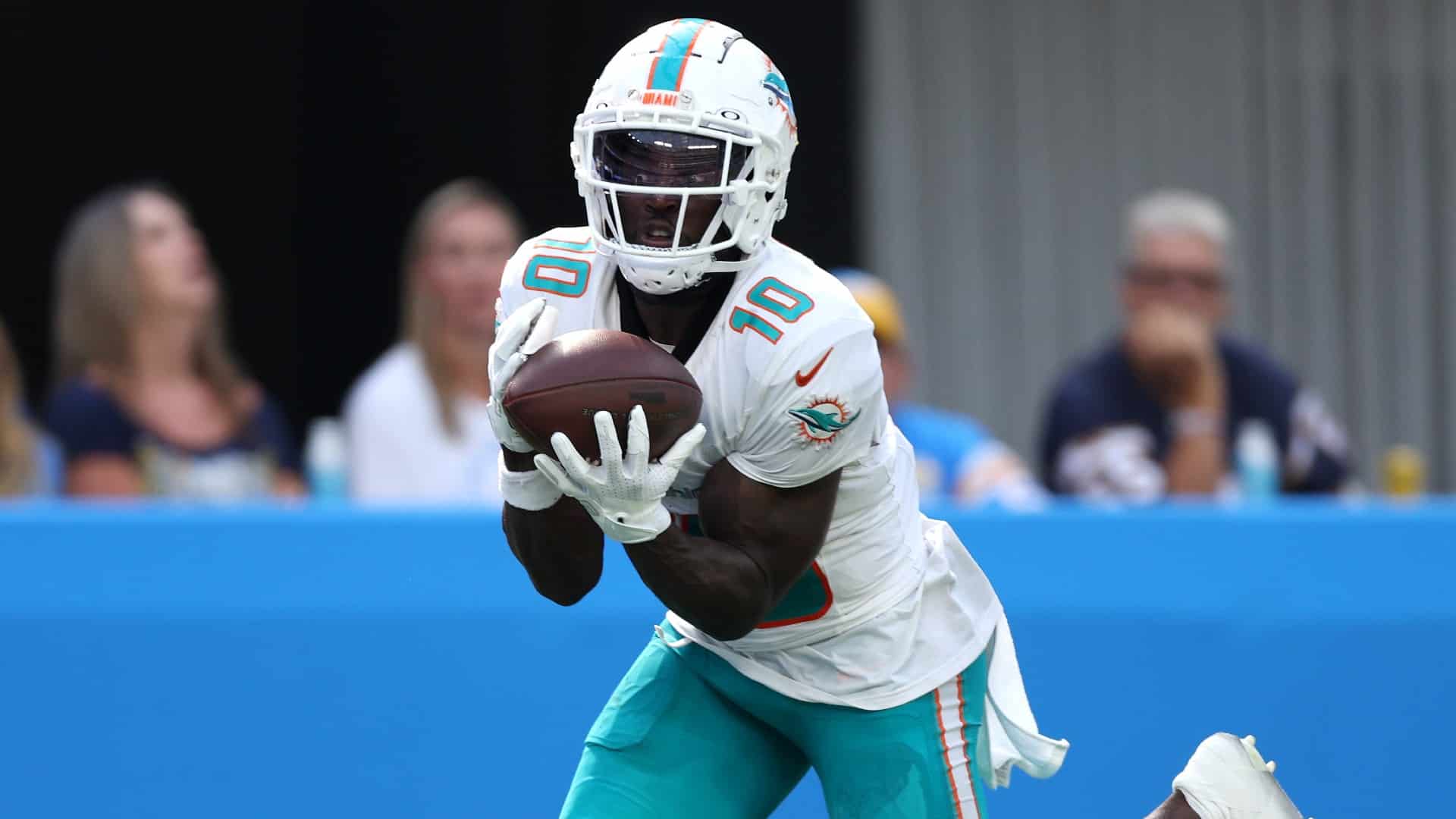
Wide Receiver in Football: Wide receivers (WRs) consistently dominate the conversation when discussing the greatest players in football history. Their breathtaking catches, game-changing touchdowns, and electrifying athleticism have etched unforgettable moments into the sport’s legacy.
Legends like Jerry Rice, Terrell Owens, Randy Moss, Cris Carter, Larry Fitzgerald, Steve Largent, Marvin Harrison, and Michael Irvin have showcased the WR position’s critical role in football. But what makes these players stand out from others who have played the same position?
Many believe that speed and good hands define a tremendous wide receiver. While those qualities are essential, they’re only part of the story. Let’s dive deeper into what it takes to excel as a wide receiver and how you can elevate your game.
What is a Wide Receiver?
A wide receiver is a key offensive player primarily responsible for catching passes from the quarterback. Positioned on the outer edges of the formation—hence the name “wide” receiver—these players use their speed, agility, and route-running ability to create separation from defenders and make plays downfield.
Their main objectives include:
- Getting open to provide the quarterback with a passing option.
- Catching the ball reliably, even under tight defensive pressure.
- Gaining yardage after the catch, using speed and agility to advance the play.
However, being a great WR requires more than just flashy catches. It demands toughness, precise route running, and a commitment to contributing to all offense facets, including the running game.
Positioning on the Field
Wide receivers typically line up on either side of the quarterback, positioned out wide near the sidelines. Depending on the offensive play, teams may deploy multiple receivers, spreading the Defense thin to exploit mismatches.
Formations often feature three or more WRs in passing-heavy offenses, emphasizing speed and route-running precision. Conversely, run-focused offenses may prioritize size and blocking ability, occasionally substituting WRs with tight ends or fullbacks.
Wide receivers can:
- Run routes to get open for a pass.
- Serve as decoys, drawing defenders away from the ball carrier.
- Block defenders to support running plays.
Regardless of the play, WRs have a pivotal role on almost every down.
Responsibilities of a Wide Receiver
To excel as a wide receiver, players must master multiple skills. Here are the primary responsibilities:
Run Precise Routes
A wide receiver’s ability to impact the passing game starts with running crisp, effective routes. The better a WR can execute the routes in the Route Tree—a collection of nine fundamental patterns—the easier it is for them to get open for the quarterback.
Consistency and repetition are critical for mastering this skill, even if a receiver excels at specific routes more than others. Precision and timing are everything.
Catch the Football
Getting open is just the first step. To thrive as a WR, catching the football reliably is non-negotiable. Great receivers can adjust to various throws, whether reaching for a high pass, diving low, or snagging a ball thrown at high velocity.
Adapting to imperfect throws while maintaining focus under defensive pressure separates good receivers from the elite.
Gain Yards After the Catch (YAC)
Elite WRs don’t just stop at catching the ball—they make things happen afterward. This requires:
- Explosiveness and speed to break away from defenders.
- Evasiveness, using jukes, spins, and fakes to extend plays.
- Physicality, breaking tackles, and shrugging off defenders to gain extra yards.
YAC is where good WRs make their highlight reels.
Block for the Team
Blocking may not seem glamorous, but being a complete wide receiver is vital. Whether on running plays or when another receiver has the ball, great WRs shield defenders and create lanes for their teammates.
By maintaining this level of commitment on every play, WRs contribute to the offense’s overall success, even when the ball isn’t coming their way.
Key Traits of a Great Wide Receiver
To summarize, here’s what it takes to excel as a WR:
- Speed: To outrun defenders and create separation.
- Hands: To consistently secure catches under pressure.
- Route Running: To confuse defenders and get open for passes.
- Toughness: To take hits, block, and play with relentless effort.
- Yardage After Catch: To turn short gains into big plays.
- Teamwork: To support running plays and create opportunities for teammates.
Whether you’re a football enthusiast or an aspiring wide receiver, understanding the nuances of this position will help you appreciate its complexity and importance. Master these skills, and you’ll be well on your way to impacting the field!
6 Key Traits of Elite Wide Receivers
Wide receivers can significantly influence a game, and having a roster of dynamic players at the position can be a game-changer for any team. Here are the traits that separate the greats from the rest:
Exceptional Athleticism
When people describe wide receivers as “athletic,” they refer to a unique combination of speed, agility, and balance.
- Quickness vs. Speed: While blazing speed is an asset, quickness is often more critical. Wide receivers rely on quick bursts to execute precise routes and gain separation from defenders.
- Agility: The ability to make sharp cuts, change direction swiftly, and explode out of breaks is essential.
- Balance: Great balance helps receivers adjust, maintain position, and secure catches—even while absorbing contact from defenders.
Reliable Hands
The hallmark of any elite wide receiver is their ability to catch the ball consistently. A receiver’s hands must be:
- Soft: To secure catches smoothly.
- Coordinated: Hand-eye coordination is crucial for tracking and adjusting to the ball mid-flight.
- Focused: Concentration is key, especially in high-pressure situations.
As the saying goes, “Receivers who can’t catch end up playing cornerback.”
Physical Strength
Strength is a vital but often underrated trait for wide receivers. It plays a role in:
- Explosive starts: Lower-body strength helps receivers burst off the line to gain separation.
- Breaking tackles: Once they catch the ball, receivers often face defenders trying to bring them down. Stiff arms and brute force help them gain extra yards.
- Blocking: On running plays, wide receivers must use upper and lower body strength to effectively block defenders, even if it’s more about angles than raw power.
Outstanding Stamina
Wide receivers are expected to run at full speed on nearly every play. Whether sprinting on routes or racing to block on running plays, their endurance is constantly tested.
- Passing plays: Receivers run full-speed routes even if they won’t be targeted on most attempts.
- Running plays: They must chase down defenders to block, often covering large field areas.
Without top-tier stamina, it’s impossible to maintain peak performance for the duration of a game.
Defensive Awareness
A deep understanding of defensive schemes separates good receivers from great ones. This includes recognizing and adapting to formations like:
- 4-3 Defense
- 4-2-5 Defense
- Cover 2 Defense
Elite receivers don’t just stick to assigned routes—they read the Defense and adjust on the fly. Recognizing openings and making split-second decisions can turn a broken play into a significant gain.
Strong Chemistry with the Quarterback
Success as a wide receiver depends heavily on a strong connection with the quarterback. Great wide receiver-quarterback duos thrive because they:
- Anticipate each other’s moves: Both players understand how the other will react in specific scenarios.
- Communicate effectively: Spending time together in the film room and on the practice field builds trust and synchronization.
Developing this chemistry takes time and effort but is crucial for consistent success.
By mastering these six traits, wide receivers can elevate their game and become indispensable team assets.
Most excellent Wide Receivers of All Time
Over the years, we’ve witnessed incredible wide receivers deliver jaw-dropping plays, spectacular catches, and game-changing touchdowns. Ranking them is no easy task, but here’s my take on the Top 10 Wide Receivers of All Time (so far):
- Jerry Rice
- Randy Moss
- Steve Largent
- Don Hutson
- Terrell Owens
- Calvin Johnson
- Larry Fitzgerald
- Cris Carter
- Marvin Harrison
- Lance Alworth
4 Essential Tips to Elevate Your Wide Receiver Game
If you’re aiming to take your skills as a wide receiver to the next level, here are four critical tips to help you get there:
Focus on Building Strength
Hitting the weight room is essential to becoming a great wide receiver.
- Lower-body strength: Improves your ability to explode off the line and power through cuts.
- Upper-body strength: Helps shed defenders, break tackles, and secure tough catches.
Strength training not only boosts your physicality but can also improve your speed.
Develop Soft Hands
You need “soft” hands that absorb the ball’s impact to catch passes consistently.
- A pass thrown at high velocity requires you to cradle the ball rather than stop it abruptly.
- Think of catching a football like catching in baseball or receiving a pass in basketball—control and cushion are key.
If your hands are “hard,” the ball will bounce off, like throwing a football against a wall.
Study the Game Thoroughly
Elite wide receivers are also students of the game.
- Know your playbook: Memorize routes and assignments for every play.
- Study defenses: Learn how defenders react and how to exploit their tendencies.
- Watch the game film: Analyze defensive patterns and ask questions to deepen your understanding.
The more you study, the sharper your instincts will become on the field.
Build Chemistry with Your Quarterback
Great wide receivers and quarterbacks have unspoken connections, anticipating each other’s moves without signals or words.
- Spend time with your quarterback during practice, film sessions, and team meetings.
- Communication and trust are the foundation for on-field success.
The stronger your bond with your quarterback, the more in sync you’ll be during critical plays.
Conclusion
The wide receiver position is one of football’s flashiest and most dynamic, known for showcasing electrifying skills and bold personalities. But genuinely great wide receivers are more than pass catchers—they’re students of the game, relentless workers, and team players.
Whether catching the winning touchdown, serving as a decoy, or blocking on a running play, great wide receivers give 100% effort on every snap. Dedicate yourself to honing your craft, and you can make a lasting impact on the field.
